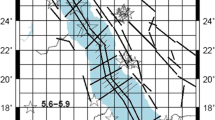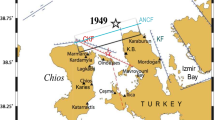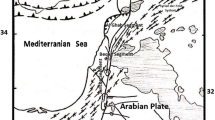Abstract
Based on all available files, catalogs, and previous compilations, it is found that 96 historical earthquakes (M ≥ 6.0) were felt along the Jordan Dead Sea Transform region during the last 2,000 years. More than 50 % of these occurred in the form of sequences and swarms that lasted for different periods, some of which were volcanic related. The largest assigned magnitude is 7.6 with 667 years recurrence period, while the maximum possible future magnitude is 7.8 ± 0.2 with 1,000 ± 80 years recurrence period. Quiescent periods, with a duration of up to 200 and 400 years and characterized by reduced levels of seismicity, are punctuated by active periods of tens of years when a few large earthquakes occurred. The historical seismicity indicates that all tectonic elements of the study region are presently active. Our results indicate that previous studies overestimate the level of seismicity in this region. Not less than 25 earthquakes, most of which had M ≥ 7.0, are erroneously related to the transform. It is probable that most of these are located within the East Mediterranean region and/or along intraplate faults, rather than the Jordan Dead Sea Transform. This is evidenced by (i) frequency–magnitude results, (ii) moderate–large East Mediterranean tsunamis, (iii) an apparent higher seismicity of the northernmost three segments compared with the southern three, (iv) relatively high annual seismic slip rate as calculated from the compiled historical seismicity, and (v) overdependence of some previous compilations on secondary rather than primary sources. The revised historical seismicity implies an annual seismic slip rate of about 0.68 cm/year, which indicates that not less than 30 % of the tectonic movements along the regional structures of the study region are aseismic. This is in agreement with results obtained from pre-historic and instrumental data.




Similar content being viewed by others
References
Abou Karaki N (1987) Synthese et carte sismotectonique des pays de la bordure orientale la mediterranee: Sismicite du systeme de failles du Jourdain-Mer Morte, Ph. D. Thesis, University of Strassbourg
Aki K (1966) Generation and propagation of G-waves from the Niigata earthquake of June 16, 1964.2. Estimation of earthquake movement, released energy, and stress-strain drop from G spectrum. Bull Earthq Res Inst 44:23–88
Al-Fryoua AA (1984) Al-Suyuti, Jalal Ed-Deen, Kashf Al-Salsala an Wasf Az-Zalzala, Al-Dar Libr., Al-Madinah Al-Munawara
Al-Qaryouti (1990) Earthquake sequences and swarms: a characteristic of the seismicity of the Jordan rift, M.Sc. Thesis, Jordan University, Amman
Ambraseys NN (1997) The earthquake of 1 January 1837 in Southern Lebanon. Ann Geofis 40:923–935
Ambraseys NN (2004) The 12th century seismic paroxysm in the Middle East: a historical perspective. Ann Geophys 47:733–758
Ambraseys NN (2005) The seismic activity in Syria and Palestine during the middle of the 8th century, an amalgamation of historical earthquakes. J Seism 9:115–125
Ambraseys NN (2008) Descriptive catalogues of historical earthquakes in the Eastern Mediterranean and the Middle East; Revisited, in Historical seismology, Modern approaches in Solid Earth Sciences, V. 2: 25 – 39
Ambraseys NN, Barazangi M (1989) The 1759 earthquake in the Bekaa Valley: implications for earthquake hazard assessment in the Eastern Mediterranean region. J Geophys Res 94:4007–4013
Ambraseys NN, Jackson JA (1998) Faulting associated with historical and recent earthquakes in the Eastern Mediterranean region. Geophys J Intern 133:390–406
Ambraseys NN, Melville CP (1988) An analysis of the Eastern Mediterranean earthquake of 20 May 1202, in W. H. K. Lee, H. Meyers and K. Shimazaki (edts) Historical seismograms and earthquakes of the World, PP. 181 – 200
Ambraseys NN, Synolakis C (2010) Tsunami catalogs for the Eastern Mediterranean, revisited. J Earthq Eng 14:309–330. doi:10.1080/13632460903277593
Ambraseys NN, White D (1997) The seismicity of the Eastern Mediterranean region 550–1 BC: a re-appraisal. J Earthq Eng 1:603–632
Ambraseys NN, Melville CP, Adams RD (1994) The seismicity of Egypt, Arabia and the Red Sea: a historical review. Cambridge Univ. Press, Camridge
Bennet RA, Rodi W, Reinlinger RE (1996) Global positioning system constraints on fault slip rates in southern California and northern Baja, Mexico. J Geophys Res 101:943–960
Clouard V Bonneville A (2003) Submarine landslides in society and Austral Islands, French Polynesia: evolution with the age of edifices, in J. Locat & J. Mienert (edts) Submarine mass movements and their consequences, Kluwer Acad Publ, PP 335 – 341
DeMets C, Dixon TH (1999) New kinematic models for Pacific-North America motion from 3 Ma to present, I: Evidence for steady motion and biases in the NUVEL-1A model. Geophys Res Letters 26:1921–1924
Doeron M, Klinger Y, Tapponnier P, Elias A, Jacques E, Sursock A (2005) Sources of the large A. D. 1202 and 1759 Near East earthquakes. Geology 33:529–534
El-Isa ZH (1985) Earthquake studies of some archaeological sites in Jordan, in Hadid, A. (edt), Studies in the history and archaeology of Jordan, II, Dept. of Antiq., Amman, PP 229 – 235
El-Isa ZH (1988) Seismic and seismological studies of the Jordan Dead Sea Transform, Science Bull. Sanaa University 6:53–72
El-Isa Z (1992) Seismicity of the Wadi Araba-Dead Sea region. Geology Arab World: 245–253
El-Isa ZH (2012) Seismicity and seismotectonics of the Gulf of Aqaba region. Arab J Geosci. doi:10.1007/s 12517-012-0604-8
El-Isa ZH (2013) Continuous Cyclic variations in the b-value of the earthquake frequency-magnitude-distribution. Earthq Sci. doi:10.1007/s11589-013-0037-9
El-Isa ZH, Al Shanti A (1989) Seismicity and tectonics of the Red Sea and Western Arabia. Geophy J Int 97(3):449–457
El-Isa ZH, Eaton DW (2013) Spatiotemporal variations in the b-value of earthquake magnitude-frequency distributions: Classification and causes. Tectonophysics. doi:10.1016/j.tecto.2013.12.001
El-Isa ZH, Mustafa H (1986) Earthquake deformations in the Lisan deposits and seismotectonic implications. Geophys J Roy Astron Soc 86:413–424
El-Isa ZH, Merghelani H, Bazzari M (1984) The Gulf of Aqaba earthquake swarm of 1983 January–April. Geophys J Roy Astron Soc 78(3):711–722
El-Isa ZH, Mechie J, Prodehl C, Makrris J, Rihm R (1987) A crustal structure study of Jordan derived from seismic refraction data. Tectonophysics 138:235–253
Geist EL (2000) Origin of the 17 July 1998 Papua New Guinea tsunami: earthquake or landslide. Seism Res Letters 71:344–351
Girdler R (1990) The Dead Sea Transform fault system. Tectonophysics 180:1–13
Guidoboni E, Comastri A, Traina G. (1994) Catalogue of ancient earthquakes in the Mediterranean area up to the tenth century, ING, Roma, SGA, Bologna, PP 504
Guidoboni E, Bernardini F, Comastri A, Boschi E (2004a) The large earthquake on 29 June 1170 (Syria, Lebanon and central southern Turkey). J Geophys Res 109:1–21
Guidoboni E, Bernardini F, Comastri A (2004b) The 1138–1139 and 1156–1159 destructive crises in Syria, south-eastern Turkey and northern Lebanon. J Seismology 8:105–127
Gutenberg B, Richter CF (1956) Earthquake magnitude, intensity, energy and acceleration. Bull Seism Soc Amr 46:105–145
Hanks TC, Boore DM (1984) Moment–magnitude relations in theory and practice. J Geophys Res 89:6229–6235
Hanks TC, Kanamori H (1979) A moment magnitude scale. J Geophys Res 84:2348–2350
Harajli M, Sadek S, Asbahan R (2002) Evaluation of the seismic hazard of Lebanon. J Seismology 6:257–277
Kanamori H, Anderson DL (1975) Theoretical basis of some empirical relations in seismology. Bull Seis Soc Am 65:1073–1096
Kawata Y, Benson BC, Borrero JC, Borrero JL, Davies HL, de Lange WP, Imamura F, Letz H, Nott J, Synolakis CE (1999) Tsunami in Papua New Guinea as intense as first thought. Earth Space 11(9):5–9
Khair K, Tsokas GN, Sawaf T (1997) Crustal structure of the northern Levant region: multiple source Werner deconvolution estimates for Bouguer gravity anomalies. Geophys J Intern 128:605–616
Khair K, Karakaisis GF, Papadimitriou EE (2000) Seismic zonation of the Dead Sea Transform fault area. Annali Di Geofisica 3:61–79
Marco S, Hartal M, Hazan N, Ley L, Stein M (2003) Archaeology, history and geology of the 749 AD earthquake. Dead Sea Transform Geol 31:665–668
Maro RD, Tertulliani A (1990) The relation between intensity and magnitude for Italian earthquakes, Pageophy, V.132, No 4
Marzouk (2008) Seismicity and seismotectonics of Egypt and surrounding region, NRIAG, Helwan, Egypt
Mechie J, El-Isa Z (1988) Upper lithospheric deformations in the Jordan-Dead Sea Transform regime. Tectonophysics 153(1–4):153–159
Meghraoui M, Gomez F, Sbeinati R, Van der Woerd J, Mouty M, Darka AN, Radwan Y, Layyous I, Al Najjar H, Darawcheh R, Hijazi F, Al -Ghazzi R, Barazangi M (2003) Evidence for 830 years of seismic quiescence from palaeoseismolgy, archaeseismology and historical seismicity along the Dead Sea fault in Syria, Earth Planet. Sci Lett 210:35–52
Papadopoulos GA, Kortekaas S (2003) Characteristics of landslide generated tsunamis from observational data, in J. Locat & J. Mienert (edts) Submarine mass movements and their consequences, Kluwer Acad. Publ., pp 367 – 374
Papazachos B, Scordilis E, Panagiotopoulos D, Papazachos C, Karakaisis G (2004) Global relations between seismic fault parameters and moment magnitude of earthquakes. Bull Geol Soc Greece XXXVI:1482–1489
Piper DJW, Mosher DC, Gauley B. –J, Jenner K, Campbell DC (2003) The chronology and recurrence of submarine mass movements on the continental slope off southeastern Canada, in J. Locat & J. Mienert (edts) Submarine mass movements and their consequences, Kluwer Acad. Publ., PP. 335 – 341
Poirier JP, Taher MA (1980) Historical seismicity in the near and Middle East, North Africa and Spain from Arabic documents (VIIth – XVIIIth Century. Bull Seism Soc Amer 70:2185–2201
Quennell AM (1958) The structural and geomorphic evolution of the Dead Sea Rift, Quart. J Geol Soc London 114:4–24
Quennell AM (1959) Tectonics of the Dead Sea Rift, Proc. 20th Intern. Geol. Congress, Mexico, 1956, ASGA, PP 385 – 403
Quennell A (1984) The western Arabia rift system. Geol Soc Lond, Spec Publ 17(1):775
Saadani A (1974) Al-Suyuti, Jala Ed-Din, Kashf Al-Salsala an wasf al-zalzala, Univ. Recher. Scien., Rabat
Salamon A (2010) Patterns of seismic sequences in the Levant-interpretation of historical seismicity. J Seismology 14:339–367
Salamon A, Hofstetter A, Garfunkel Z, Ron H (1996) Seismicity of the eastern Mediterranean region: perspective from the Sinai subplate. Tectonophysics 263:293–305
Salamon A, Ward S, T. Rockwell (2006) Tsunami hazard to the bay of Haifa: historical analysis and selected modeling, Report GSI/09/2006, Jerusalem,41PP
Salamon A, Rockwell T, Ward SN, Guidoboni E, Comastri A (2007) Tsunami hazard evaluation of the eastern Mediterranean: historical analysis and selected modeling. Bull Seismol Soc Am 97:705–724
Sbeinati MR, Darawcheh R, Mouty M (2005) The historical earthquakes of Syria: an analysis of large and moderate earthquakes from 1365 B.C. to 1900 A.D. Ann Geophys 48:347–435
Tappin DR, Watts P, McMurtry GM, Lafoy Y, Matsumoto T (2001) The Sissano Papua New Guinea tsunami of July 1998—offshore evidence on the source mechanism. Mar Geol 175:1–23
Utsu T (1990) Catalog of damaging earthquakes in the world (through 1989), Utsu, Tokuji, Tokyo, 243PP. (in Japanese)
Wells DL, Coppersmith KJ (1994) New empirical relationships among magnitude, rupture length, rupture width, rupture area and surface displacement. Bull Seis Soc Am 84:974–1002
Willis B (1928) Earthquakes in the Holy Land. Bull Seism Soc Amer 18:73–103
Willis B (1933) Earthquakes in the Holy Land: a correction. Bull Seism Soc Amer 23:88–89
Wynn RB, Masson DG (2003)Canary Islands landslides and tsunami generation: can we use turbidite deposits to interpret landslide processes? in J. Locat & J. Mienert (edts) Submarine mass movements and their consequences, Kluwer Acad. Publ., PP 325 – 332
Wyss M (1979) Estimating expectable maximum magnitude of earthquakes from fault dimensions. Geology 7:336–340
Acknowledgments
This work was completed during a sabbatical year the first author spent at the University of Calgary, Canada, with financial support from the University of Jordan, Amman, Jordan.
Author information
Authors and Affiliations
Corresponding author
Rights and permissions
About this article
Cite this article
El-Isa, Z.H., McKnight, S. & Eaton, D. Historical seismicity of the Jordan Dead Sea Transform region and seismotectonic implications. Arab J Geosci 8, 4039–4055 (2015). https://doi.org/10.1007/s12517-014-1483-y
Received:
Accepted:
Published:
Issue Date:
DOI: https://doi.org/10.1007/s12517-014-1483-y




